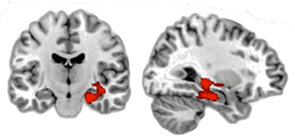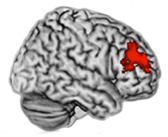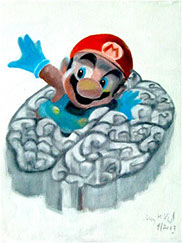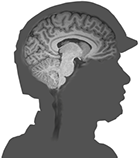Neuroplasticity and Training
My aim is to address the question whether and if so how plasticity contributes to adult development on both the behavioural and neural level. Research is currently discovering the large capacity the human brain has to adapt to changing demands by altering its function and structure (Lövdén, Bäckman, Lindenberger, Schaefer, & Schmiedek, 2010).
We assume that the degree of mismatch between environmental demands and the individuals’ current capacity determines the degree of change. Within this framework, we are interested in changes in both directions: growth in situations where the demands are higher than the available capacity, as, for example, in cognitive training studies, but also decline in situation were the capacity is higher than the current demands, as e.g. in immobilization or sensory deprivation.
Since the mechanisms of change and the sequential progression of plasticity are largely unknown our main goal is to fill this research lacuna.
Training with video games
Video gaming has become more and more pervasive across the lifespan as well as across cultures. Nowadays, people worldwide spend a collective three billion hours per week playing video games (Zimbardo & Duncan, 2012). This intense exposure is bound to have effects on structure and function of the brain, and this is what we set out to explore.
In a study on male adults we found a positive association between hours spent with video games over the entire lifetime and grey matter volume in bilateral entorhinal cortex, a brain region that plays a role in orienting in our environment (Kühn & Gallinat, 2014).
Yet, caution is called for in the interpretation of cross-sectional results. The observed volumetric effects could likewise be a precondition rather than consequence of video gaming.
To investigate the causal effects of video gaming we conducted a training study in which adults played Super Mario 64 for 8 weeks, 30 minutes a day. We were able to show that grey matter volume in the right hippocampus and dorsolateral prefrontal cortex as well as the cerebellum increased in the experimental group compared to the control group that was not trained (Kühn, Gleich, Lorenz, Lindenberger, & Gallinat, 2014).

Right HC

Right DLPFC
However, it is worth noting that the term "video games" is far from a single construct; there are millions of individual games and hundreds of distinct genres. Simply put, if one wants to know what the effects of video games are, the devil may hide in the detail. Therefore, we need to explore the effects of different gaming genres and to investigate the mechanisms that powerfully motivate people across all ages to play video games.

Currently ongoing studies:
• GTA vs. Sims: In this study we test how playing the rather violent video game Grand Theft Auto affects constructs like impulse control, delay discounting, empathy and aggression in comparison to the more prosocial game The Sims.
• In a more clinical study (funded by SFB 936) we investigate potential positive effects of playing Super Mario 64 on symptoms of schizophrenia patients. Schizophrenia patients are known to show morphometric deficiencies in hippocampus and prefrontal cortex, exactly the brain regions in which we observed structural plasticity effects after training with the video game in healthy participants (Kühn, Gleich, Lorenz, Lindenberger, & Gallinat, 2014).
Plasticity effects in response to deprivation
In this series of experiment we focus on environmental effects that may have detrimental effects on brain plasticity. In most of our studies we focus on developing interventions to enhance brain plasticity, however this is particularly relevant in populations that suffer from predicted decline in brain plasticity.
In a recent study we have assessed brain structure before and after scientists went to the Neumayer Station of the Alfred-Wegener Institute in Antarctica to overwinter there. Our assumption was that Antartica provides less spatial cues and therefore navigation skills and hippocampal brain structure may be affected.
An on-going study investigates another so-called space analogue environment, namely bedrest at the National Aeronautics and Space Research Centre in Cologne. In bedrest studies healthy participants are positioned in a head-supine position for several weeks in order to simulate the effects of microgravity that affect astronauts during space flights.
Finally we are planning to conduct a study exploring brain structural and functional changes in the astronauts/cosmonauts staying on the International Space Station (ISS).
Plasticity effects of Stress
In a series of studies we aim to investigate plasticity processes in response to traumatic and stressful events as well as the development of post-traumatic stress disorder (PTSD). Moreover, we wish to assess the effects of therapeutic intervention on a PTSD population and to explore novel interventions for PTSD.
In one of the largest scale studies of PTSD ever conducted using fMRI, soldiers are assessed before and after deployment to armed conflict and post-conflict zones, using a battery of neuroimaging and psychological measures. For this study we collaborate with the German Military (PD. Dr. Peter Zimmermann, Dr. Gerd Willmund). The study aims to assess whether the structural and functional changes, in particular within the hippocampal formation (Kühn & Gallinat, 2013), observed in a PTSD population are present prior to PTSD (vulnerability hypothesis) or arise as a result of the development of PTSD (acquisition hypothesis).

Plasticity effects of hormones
In this project, we are studying the influence of hormones on the brain structure. Animal studies demonstrated that female hormones, as oestrogen for instance, can influence the brain as well as the behaviour. We set out to investigate those effects and their interplay in humans.
In a first study women were measured at four time-points during their menstrual cycle. Brain structure was assessed by means of magnetic resonance imaging (MRI). Our results show that the volume of the hippocampus, a brain structure that is important for memory and spatial abilities, differs across the menstrual cycle and that its functional connectivity changes (Lisofsky et al., 2015a). In a meta-analysis on previous functional MRI we also observed functional changes in the hippocampus and the amygdala (Lisofsky et al., 2015b).
An on-going project is concerned with the influence of pregnancy and childbirth on the brain structure memory of women. Previous studies show decreasing memory capacities in pregnant women, regenerating during the months after birth. We are interested in the neuronal basis of these transformations.
In a second study we aim at investigating if and how the regular use of oral hormonal contraceptives can influence the brains structure and function.
Plasticity effects during aging (BASE II)
As in other countries, life expectancy in Germany is rising. The researchers of the Berlin Aging Study II (BASE-II) investigate how these additional years can be lived healthily and actively. The Berlin Aging Study II is an extension and expansion of the longitudinal Berlin Aging Study (BASE). In 1990–1993, this interdisciplinary study initially examined 516 men and women of the western part of Berlin aged between 70 and 100 and has continuously followed them up to the present.
The continuation study BASE-II investigates the physical, cognitive, and social conditions that lead to successful aging. 2,200 Berlin residents are being investigated. They form two groups: 1,600 participants belong to the older sample aged between 60 and 80, and 600 participants are between 20 and 35. The group of younger people functions as a reference group for the group of older participants. Repetition of the assessments approximately every three years is in planning to gain information about aging over time. The first wave of data collection started in 2009 and will continue until 2014.
I have started to investigate a subsample of BASE-II participants (N=450) with functional and structural magnetic resonance imaging (MRI) and plan to continue this on a longitudinal basis to investigate the aging brain.
Day-to-day variability of MRI measures (Day2Day study)
Within the scope of this project, we wish to characterize how the brain changes on a day to day basis and how environmental and scanner variables contribute to these differences.
We (that is Elisa, Elisabeth, Johan, Martyna, Maxi, Nina, Oisin and myself) set out to get an MRI scan twice a week over a period of half a year.
This ambitious study will shed light on the dynamics of brain structure and function and will provide a unique opportunity to investigate the stability of MRI measurements over time.
In addition to the structural and functional images of our brains we record parameters such as body weight, body composition, mood, physical activity, weather and nutritional information. Furthermore we aim at using this data to determine sources of variability in the MRI measurement itself, such as Helium level, temperature and humidity in the scanner room.
Verwendung des Super Mario Charakters mit freundlicher Genehmigung der Nintendo of Europe GmbH. Super Mario und Super Mario Bros. sind eingetragene Warenzeichen der Firma Nintendo Co., Ltd